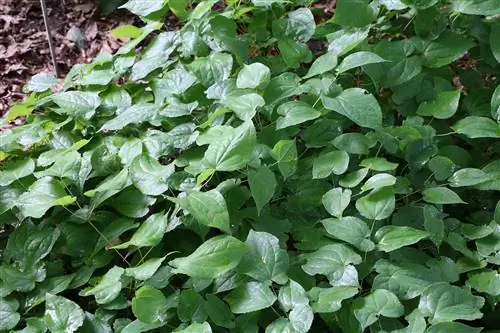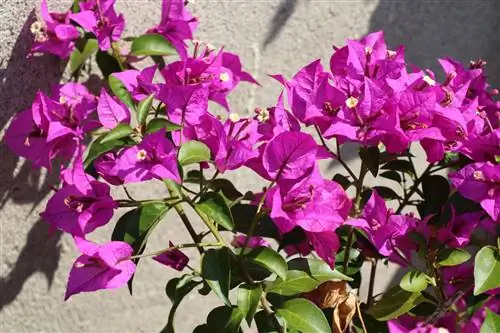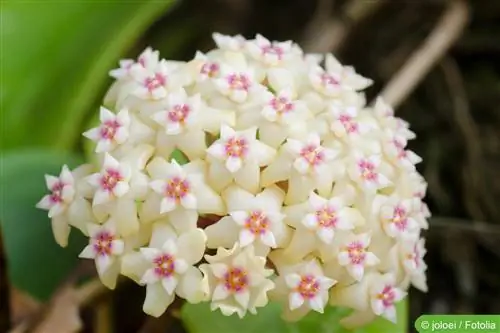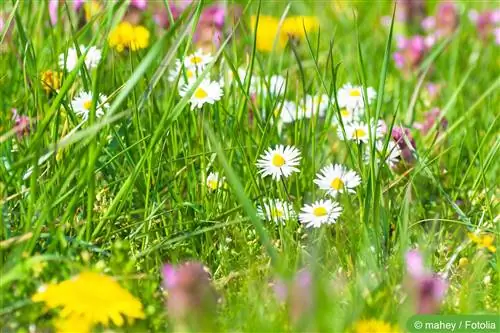- Author admin [email protected].
- Public 2023-12-17 03:39.
- Last modified 2025-01-24 12:45.
Here is an extensive portrait of the phlox, which is also known as phlox.
Profile
Species/Family: Perennial. Belongs to the weed or sky ladder family (Polemoniaceae)
Care effort: Medium. Delicate perennial that needs to be cared for
Flowering time: June to September with small, wheel-shaped individual flowers in dense umbels in red, pink, blue, purple, white, often bicolored. Blooms from below. Often fragrant, especially towards evening. Flowering time can be extended if 1/3 of all shoots are cut back in June
Foliage: Narrow egg-shaped in fresh green. Some varieties are more needle-like. Already densely leafy from below
Growth: Tight, upright, clump-like growth
Height/Width: 10 to 150cm high and an average of 50 to 60cm wide
Care
Location: Sunny to partially shaded, depending on the species. Nutrient- and humus-rich, permeable, deep, moist soil (see location and soil conditions below)
Planting time: Cold germinator. The best time to plant is autumn. Many species and varieties can be grown from seeds outdoors from March to May. Germination time 15-25 days at 18-25 degrees Celsius
Pruning: Cutting back 1/3 of the shoots in June extends the flowering period. Prune close to the ground in late autumn or better in spring before new growth
Partner: Beautiful in tuffs with several Phlox species
Propagation: Division in autumn. Take cuttings in spring. It sows itself quickly in suitable locations if the flowers are left standing. However, this leads to the rapid displacement of the originally planted noble varieties
Care: Apply compost in spring and organic fertilizer in April or use slow-release fertilizer as an alternative. Requires watering on hot dry days, soil should not dry out
Wintering: Requires winter protection in harsh areas. Should be protected especially from bar frosts (frosts without snow)
Diseases and problems
If the shoots are deformed and/or grow poorly, nematodes are usually to blame. Remove affected shoots immediately and plant marigolds as protection against soil organisms
Is susceptible to powdery mildew in wet summers (especially some varieties). Since this fungal disease is difficult to get under control, it is better to separate the susceptible varieties. When watering, do not water over the leaves
Special features:
- Wild species comes from North-East America
- Was voted perennial of the year by the Association of German Perennial Gardeners in 2006
- Popular butterfly and bee pasture in white and pink, also very popular with moths
- You can usually find hybrids in stores
- Can be easily cut for the vase (see cut flowers below)
- Also suitable for pot planting
Tip:
Carefully remove individual flowers from the inflorescence and suck the sweet nectar at the base (like lilac flowers)
Species (selection of over 60 species)
Big Flame Flower
See the species Tall Perennial Phlox below
Large Perennial Phlox
See the species Tall Perennial Phlox below
Tall perennial phlox (Phlox paniculata)
Is often only offered as perennial phlox, as large phlox or as large perennial phlox. Best known and most popular classic. Height 30-120cm. Blooms from June to October in white, red, purple or pink. Tolerates sunny or semi-shady location
Moss Phlox - Carpet Phlox - Upholstery Phlox - Dwarf Phlox (Phlox subulata)
Height 10-15cm. Blooms from April to June with many small star-shaped flowers in purple, white, red or pink. Wintergreen. Needle-shaped, small, stiff, strong green leaves. Ground cover that quickly forms wide and flat cushions. Likes it to be warm, sunny with some sandy soil. Blooms later and for shorter periods in partial shade. Is native to North America. Good for the rock garden, as a roof garden plant or for bordering beds. Can beautifully conceal wall edges through overgrowth
Summer Phlox (Phlox x arendsii, Phlox drummondii)
Blooms from June to July. Often offered as seeds
Perennial Phlox
See the species High Perennial Phlox above
Carpet Phlox
See the species moss phlox above
Forest Phlox (Phlox divaricata)
Height 40cm. Blooms from April to June in blue-violet or white. Prefers a partially shaded location. Can also tolerate full sun if the soil moisture is sufficient
Meadow Phlox (Phlox maculata)
Height 80-150cm. Prefers a sunny location, but can also cope with partial shade
Varieties (selection)
- `Aida: Tall perennial phlox. Height 90cm. Blooms in violet-red
- `Alpha: meadow phlox. Height 150cm. Flowers from June to September in violet-pink
- `Amethyst: Tall perennial phlox. Height 80-120cm. Blooms from June to August with intense purple flowers with slightly light purple markings
- `Blue Paradise: Tall perennial phlox. Height 100cm. Newer hybrid breeding with striking blue flowers
- `Brilliant: Strongly scented
- `Candy Stripes: Moss Phlox. Very beautiful white-pink striped flowers
- `Cinderella: Strongly scented
- `Clouds of Perfume: Forest Phlox. Height 40cm. Blue-violet flowers with a strong, pleasant scent
- `David: Tall perennial phlox. Height 50cm. Impresses from July to September with exceptionally large flowers in pure white
- `Village Joy: Strongly scented
- `Emeralda Cushion Blue: Moss Phlox. Particularly richly flowering variety with light purple flowers
- `Eva Foerster: Strongly scented
- `Countess of Schwerin: Strongly scented
- `Höhnau: Strongly scented
- `Hochgesang: Tall perennial phlox. Flowers from August to September in white
- `Karoline: Strongly scented
- `Country wedding: height 120-140cm. Delight with pink flowers with a red eye in them
- `Laura: Tall perennial phlox. Height 80cm. Flowers from June to September in dark pink with a white eye
- `Lilac Flame®: height 30-40cm. Blooms from July to September in dark pink-purple with a star-shaped white center. Strongly scented
- `Omega: meadow phlox. Height 80cm Flowers from July to August in white-red
- `Orange: Tall perennial phlox. Height 80-140cm. Stands out with flowers in strong, bright orange
- `Pallas Athene: Strongly scented
- `Pax: Tall perennial phlox. Height 90cm. Pure white flowering variety
- `Peppermint Twist: Tall perennial phlox. Newer variety. Height 50-80cm. Blooms from July to September with pink and white striped flowers. Slightly scented
- `Pink Pom: See the variety `Pink Pong below
- `Ping Pong: Tall perennial phlox. Also called `Pink Pom. Height 80cm. Blooms from July to September with bright pink flowers and darker pink centers
- `Purple Dome: Strongly scented
- `Red Feelings®: Tall perennial phlox. Height 70cm. Blooms bright red from July to October
- `Roselight: Strongly scented
- `Scarlet Flame: Moss Phlox. Catches the eye with its scarlet flowers
- `Schneeferner: Tall perennial phlox. Height 80-120cm. Blooms from June to August with pure white flowers with attractive, small, yellow centers
- `Sherbet Cocktail®: height 70cm. Blooms from June to September in dark pink with yellow edges. Newer variety that is considered robust
- `Summer joy: Tall perennial phlox. Height 90cm. Pink flowers with red eye
- `Temiscaming: Very vigorous variety with bright purple flowers
- `Violet Seedling: Moss Phlox. Shows reddish-purple flowers
- `If already, then already: Tall perennial phlox. Height 90cm. Beautiful, clear purple flowers with a contrasting white eye
- `White Delight: Moss Phlox. Enchanted by snow-white flowers
- `White Perfume: Forest Phlox. Height 40cm. White flowering counterpart of `Clouds of Perfume, which smells just as pleasant
- `Windsor: Tall perennial phlox. Height 80cm. Flowers shine in bright orange-red
General
The probably most famous phlox breeder Karl Foerster said about the plants: A garden without phlox is not just a mistake, it is a sin against summer.
Even if not everyone shares this opinion, the phlox are clearly one of the most popular and certainly one of the most beautiful summer bloomers. Originally from America, phloxes are now firmly established in German gardens, even though most species and varieties are cultivated and there is not much left of the wild species. There are already over 60 species of the plant, which feels most comfortable in sunny to partially shaded, moist locations. Some species would like a little more sun, others prefer partial shade, so there is something right for most garden areas.
Location and soil conditions
Flame flowers are beautiful, but also delicate. They cannot tolerate heat or drought, but they also take care quickly when they are constantly wet.
Phlox loves cool, airy locations and loamy-humus-rich soil, which should be neutral to slightly acidic
Cut flowers
As a cut flower, the phlox has a moderately long shelf life and is very popular. However, you shouldn't just start chopping away if you want to enjoy the perennial for longer.
Plants need their leaves to absorb water and nutrients, that is well known. Since the phlox now has its leaves on the flower stalks, not too many should be cut off to ensure further growth. A maximum of 1/3 of the flower stems may be cut for the vase






